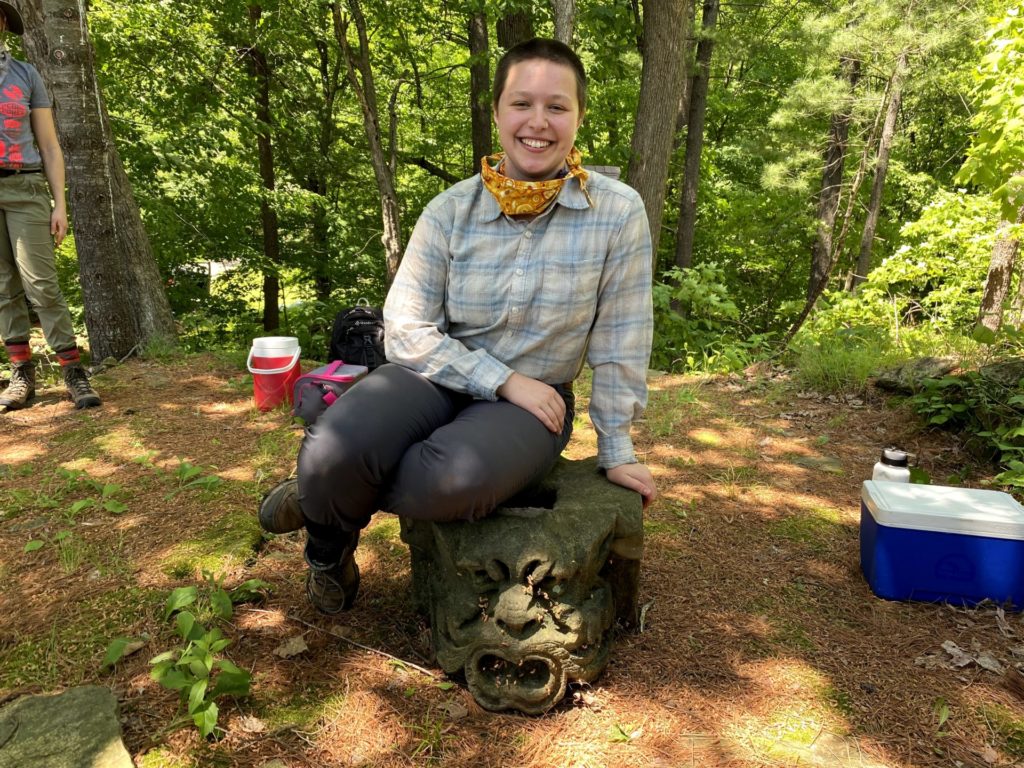- Home
- >
- Preservation Archaeology Blog
- >
- On Archaeology: Abby Thomsen
Tomorrow, October 16, is International Archaeology Day. This annual event is organized by the Archaeological Institute of America, and there are a lot of great events and activities to choose from.
When we can, we like to commemorate IAD with a blog series. This year, several members of our staff will be writing about their responses to the following questions: As you were getting into the field (or, if you are not an archaeologist, as you were starting your job at Archaeology Southwest), what did you think archaeology was? What do you think it is now? What should archaeology be?
We’ll have a new post almost every Friday through the end of the year. First up is Abby Thomsen. Abby recently moved to Tucson from Minnesota.

(October 15, 2021)—My childhood bookshelf was filled with Greek and Roman mythology, from classic tales to retellings like the Percy Jackson series by Rick Riordan. I couldn’t get enough of these stories of triumph and betrayal, gods and heroes, and I puzzled babysitters when I pulled out large tomes for bedtime stories, demanding the story of “Nickbee,” or the naked baby, Cupid.
Somewhere along the way, I learned that these stories had roots in the physical environment—archaeologists had unearthed temples, shrines, and colossal statues in honor of gods. I never played much in the dirt, but that was because I didn’t know I could dig for stories.
I enrolled in Latin with visions of myself—complete with pith helmet, of course—unearthing tablets inscribed with stories that hadn’t yet made their way into the books on my shelves. A grueling year with Caesar’s De Bello Gallico caused that dream to turn to dust, and I entered college with other ambitions.
It wasn’t until I enrolled in a Cultural Resource Management (CRM) archaeology course that digging for the past re-entered my consciousness, this time in nearer soils. In class, I learned about the history of preservation in the United States, how the protection of Indigenous lands and sites came following waves of genocide and forced removal. I learned from Dakota and Ojibwe Tribal resource managers that so often archaeological research in the US entrenches Indigenous people as people of the past, that well-meaning white people digging for stories where descendants had been removed perpetuates the myths of terra nullius and the vanishing Indian.
Terra nullius is the idea that the land in what is now the United States was empty and divinely destined to be colonized by Europeans. The Myth of the Vanishing Indian, a term coined by Brewton Berry in 1960 in a deeply racist article, refers to the fact that White settlers have sought to absolve themselves of the responsibility for genocide and continued crimes against Native Americans by pretending Indigenous peoples are extinct. White settlers have exploited Indigenous sites for their own gain, to the point of putting Native human remains on display in museums.
These actions of past archaeologists, whether intentionally or not, served to assert dominance over Native peoples past and present, and created the myth that, as Vine Deloria wrote in 1973, according to white people, “the only real Indians are dead ones.”

Examining this history made me question why I signed up for a field school to learn how to excavate on the ancestral lands of the Dakota people. I turned to Indigenous scholarship to learn about ethical practices of community-based, Indigneous-led archaeology.
In her 2006 essay, “Indigenous Archaeology as Decolonizing Practice,” Dr. Sonya Atalay, an Ojibwe scholar at the University of Massachusetts, Amherst, states that when archaeology is conducted by, with, and for Indigenous peoples, it can serve as a form of gikiniwaabi, the “passing or reproduction of knowledge, through experience, from elder to younger generations.” Colonization has interrupted many Indigenous knowledge systems, through murder and violent assimilation strategies, and Indigneous-led archaeological projects can help to restore information that was lost or forcibly taken.
Today, as a white person trained in American archaeology, my role is to center and support community-led initiatives, and to build connections with communities my ancestors harmed. I reject the visions of a lone savant researcher “discovering” “lost” stories, and instead ask myself what my place is in the history that lives both beneath my feet and all around me. The desire to unearth stories pulls many of us into the field, and I believe that white archaeologists must hold onto the desire to learn, and must learn to see archaeology as an entry point. Archaeology can teach us all about more than just a single site, or about a certain period of the past. It gives us an opportunity to examine the complex factors that led us to today—American imperialism, Indigenous strength and resilience—and encourages archaeologists to visualize our own roles in rewriting the harmful narratives our predecessors told.
3 thoughts on “On Archaeology: Abby Thomsen”
Comments are closed.
Well said. Thank you for helping move the discipline ever so much toward a just path.
Socrates said it. I believe it. You’ve settled it: Knowing yourself is the foundation for any meaningful knowledge of the world.
Wise words. A a young professional of the new generation, I am encouraged that native people can begin to trust the intentions of the other.